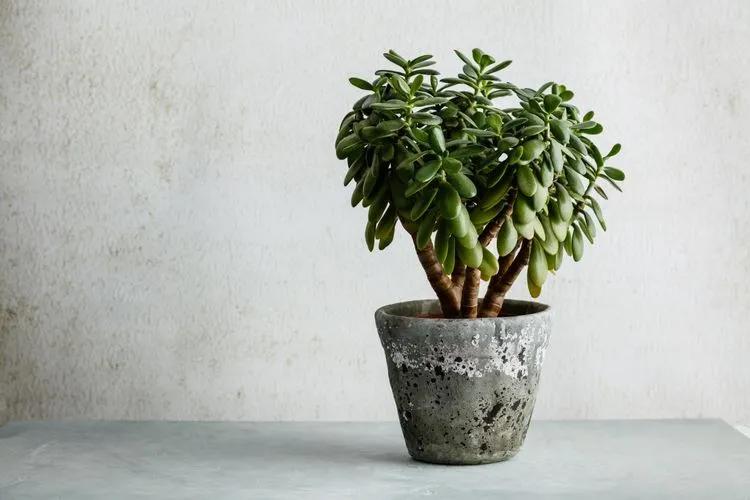 In this article, we will talk about the money tree, tell you in detail about care, the specifics of the natural habitat, and much more. Growing tips will also be given, following which you can grow the perfect houseplant and admire it for many years.
In this article, we will talk about the money tree, tell you in detail about care, the specifics of the natural habitat, and much more. Growing tips will also be given, following which you can grow the perfect houseplant and admire it for many years.
Basics
The Jade Plant is a shrub succulent that came to us from South Africa. This plant has quite a few different names. The most popular were “Money Tree” and “Jade Plant”. This is due to the fact that the color of the leaves of the flower resembles the shade of the mineral itself. Belongs to the Crassula genus, which has an average of 300-500 varieties. The money tree is easily recognizable by its thick leaves, which will be very smooth and rich in green. But the branches of the plant with age begin to become wider and stiffen. In a normal habitat, it can reach 2 meters, but at home - no more than one meter, since the crown of a plant can be formed independently.
Watering
In the warm season, it is worth watering the plant as the soil dries up. But in the cold season and during the rest period - watering should be reduced to 1-2 times a month. The increased moisture content of the soil will be detrimental to the root system of the plant, the roots will begin to rot. It is also worth spraying the leaves from a spray bottle with water at room temperature, and it will not be superfluous to wipe the leaf plates with a damp cloth, several times a month is enough.
Temperature
 The average temperature will be 20-25 degrees Celsius (68-77 degrees Fahrenheit). In winter, the jade plant thrives at temperatures between 10-14 degrees Celsius (50-57.2 degrees Fahrenheit). Also, for a very short time, it can tolerate a drop in temperature to 0 degrees (32 degrees Fahrenheit).
The average temperature will be 20-25 degrees Celsius (68-77 degrees Fahrenheit). In winter, the jade plant thrives at temperatures between 10-14 degrees Celsius (50-57.2 degrees Fahrenheit). Also, for a very short time, it can tolerate a drop in temperature to 0 degrees (32 degrees Fahrenheit).
Light
Do not put the Jade Plant bastard under the influence of direct sunlight, this will lead to burns, which will appear as dark spots on the leaves. But it is not advisable to grow a plant in the shade, this will lead to the consequences of stretching the shoots and their thinning. Partial shade will be best; a landmark on the south or west side is also suitable. If you live in a tall building, then choose the northwest. Dose the amount of light by turning the pot in different directions towards the sun.
Other recommendations
Tips from different areas of money tree care will be listed below. This will help you do everything right and not harm your pet.
1.Soil This plant prefers soil that easily combines drainage functions. The succulent plant should be in medium humidity and overflow should not be allowed. You can use a ready-made soil mixture for cacti, or add to the existing perlite in a 1:1 ratio.
- Top dressing Fertilizers should be applied once a month. the procedure involves preliminary watering a day before feeding and after, adding liquid fertilizers to the soil. Best suited for cactus or succulent plants.
3.Rest period It falls on the time from the beginning of October to March. At this time, you need to adhere to some rules so that the plant endures winter without stress.
- The temperature should be between 5-13 degrees Celsius (41-55.4 degrees Fahrenheit).
- At this time, the succulent cannot be fertilized.
- Reduce watering to several times a month.
4.Diseases
- Mealybug
- Aphids
- Sciarids
- Wine weevil Before you start pouring various drugs into the plant or treating it with folk methods, it is worth eliminating the cause of the occurrence. You need to adjust the watering, check the lighting, and create the desired temperature. Replacement with soil and treatment with fungicides also does not interfere.
5.Repotting Both young and more mature specimens are transplanted. Young plants need a transplant once a year, and old ones - once every 2 years. For plants of a more mature age, you need to buy a pot 2 centimeters larger than the previous one, this is due to the fact that the root system becomes larger and the money tree becomes cramped. You need to prepare the soil mixture and drainage in advance, expanded clay will do. The plant is carefully removed from the pot, excess soil is removed from the roots. If you see rotten roots, cut them off, treat the cut points with charcoal. Place gently in a new pot and start filling the sides with soil, lightly tamping down the soil.
